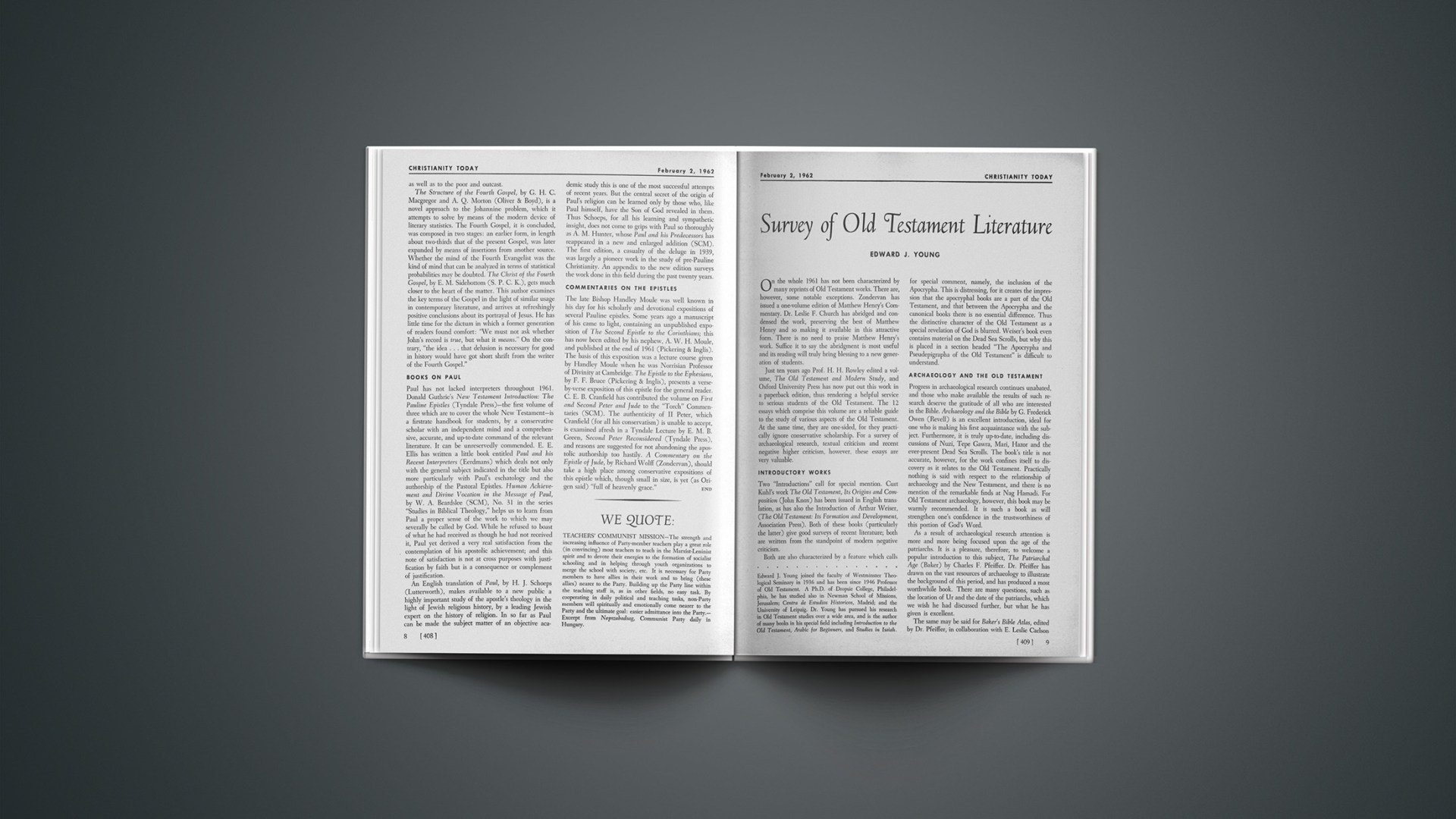Pride of place must be given in a survey of New Testament literature in 1961 to The New English Bible: New Testament (Oxford University Press; Cambridge University Press), published on March 14. As this work was reviewed by the present writer in CHRISTIANITY TODAY, March 13, it calls for no further mention here. Another version is the Simplified New Testament, by Olaf M. Norlie (Zondervan), a rendering “in plain English—for today’s reader” by a veteran Lutheran scholar, based on the Received Text. (It includes as an appendix a scholarly translation of the Psalms by Professor R. K. Harrison.) We welcome an old favorite in the reappearance of The Twentieth Century New Testament (Moody Press), first published sixty years ago. In the new edition the common order of the books is preserved (the original edition attempted to arrange them in chronological sequence), and some minor modifications have been made in the rendering. This may be regarded as a good translation, carried out by a body of thirty enlightened but non-specialist Christians.
General Works
Alpha and Omega, by S. H Hooke (Nisbet), presenting the substance of the “Speaker’s Lectures” delivered at Oxford between 1956 and 1961, is a study in the pattern of revelation to be traced in both Testaments, by a veteran English scholar now approaching his ninetieth year. It is a fresh exposition of the essential unity of all Scripture. New Testament Apologetic, by Barnabas Lindars (SCM), examines the doctrinal significance of the Old Testament quotations in the New Testament, and finds that the requirements of early Christian apologetic have in large measure dictated their use and application. Studies in New Testament Ethics, by William Lillie (Oliver & Boyd), is the work of a man who takes seriously the relevance of the gospel to ordinary conduct. After paying proper tribute to the ethical heritage of the Old Testament, he considers some ethical problems which the New Testament propounds, various spheres of behavior to which the New Testament has something important to say, and three elements which are fundamental to the ethical outlook of the New Testament—eschatology, self-denial, and love.
F. F. Bruce is Rylands Professor of Biblical Criticism and Exegesis at the University of Manchester, England. He holds the B.A. from Cambridge University, M.A. and D.D. from Aberdeen University. He is Editor of The Evangelical Quarterly and of the Palestine Exploration Quarterly. Most recent of his books is The English Bible: A History of Translations.
For the general reader W. S. LaSor has written a fine book on Great Personalities of the New Testament (Revell). For the student M. C. Tenney has produced a revised edition of his excellent New Testament Survey (Eerdmans), containing illustrations and maps, new material on the Gospels and the Dead Sea Scrolls, and a new chapter on text and transmission. At a still higher level we have an English translation by R. W. Funk of A Greek Grammar of the New Testament and Other Early Christian Literature, by the late F. Blass and A. Debrunner (University of Chicago Press). The translator has benefited by the help of the Cambridge scholar W. P. M. Walters (otherwise Peter Katz), who for many years was closely associated with Debrunner. The work is uniform with Arndt and Gingrich’s Lexicon, and is a worthy companion to it; both volumes ought to lie ready to the hand of every English-speaking preacher and theological student. The Text of the New Testament by Vincent Taylor (Macmillan) provides the beginner in New Testament textual criticism with a short and helpful introduction.
Translations And Expositions
The new English translations of Calvin’s commentaries on books of the New Testament appear with happy frequency; thus far we have welcomed four volumes: John 1–10; John 11–21 and First John; First Corinthians; Romans and Thessalonians (Eerdmans). The translators, T. H. L. Parker, John W. Fraser and Ross Mackenzie, have done their work well; we now have these commentaries in more readable as well as more accurate English. Further translations of Walter Lüthi’s homiletical expositions have come to hand; 1961 has seen the publication of The Lord’s Prayer and The Letter to the Romans (Oliver & Boyd). These volumes are highly recommended to the preacher; they set forth clearly the meaning of the biblical text and at the same time show how expository sermons ought to be preached. In this last respect they may serve as practical illustrations of Edmund P. Clowney’s thesis in Preaching and Biblical Theology (Eerdmans).
The Qumran Texts
The bearing of the Qumran discoveries on the Gospels receives quite distinguished treatment from Matthew Black in The Scrolls and Christian Origins (Nelson). Black draws attention to the substantial evidence for two main strands (a northern and a southern) of nonconformist Judaism before and during the life of Christ. The Qumran texts give us one expression of the southern variety, while the northern variety characterized the milieu into which Christ was born. By contrast with such a scholarly work as Black’s we may give a passing mention to The Essene Christ, by Upton T. Ewing (Philosophical Library), “a recovery of the historical Jesus and the doctrines of primitive Christianity” which makes the first phase of Jesus’ pathway begin at Qumran and treats the Qumran texts with the same freedom as it does the New Testament documents.
Special Studies
The Earliest Lives of Jesus, by Robert M. Grant (S. P. C. K.), gives a lively account of the place which the four Gospels hold in the thinking and writing of the early Christian Fathers—who, it appears, were not so critically naïve in questions of text, history and literary relationships as has too often been asserted. Paul Winter’s study On the Trial of Jesus (De Gruyter, Berlin), the first volume in a series titled Studio Judaica, is a work of high scholarship which takes account of all the available sources of relevant information; some of the data, however, lend themselves to a different interpretation from that reached by the author. This is so, for example, with his discussion of the Sanhedrin’s right to execute the death sentence in A. D. 30.
Commentaries On The Gospels
Two Tyndale New Testament Commentaries have appeared in the course of the year—Matthew, by R. V. G. Tasker, and Mark, by R. A. Cole (Eerdmans). Both of them maintain the high standard set by previous volumes in this series. Professor Tasker is general editor of the series, and Matthew is the fourth volume which he himself has contributed. He was a member of the New Testament translators’ panel for the New English Bible, and in an appendix he discusses some of the renderings of Matthew’s Gospel in the NEB A comparison of the two commentaries indicates that he and Dr. Cole do not see altogether eye to eye on some aspects of Synoptic criticism; it would be a dull world if all commentators—even all evangelical commentators—thought alike on everything! The volume on Matthew in the Epworth Preacher’s Commentaries has been written by A. Marcus Ward (Epworth). It will be of most help to the class of readers for whom this series is chiefly intended—Methodist lay preachers (and, one should add, non-Methodist preachers, whether lay or ordained). The exposition is practical and homiletical, but there is no mistaking its sound scholarly basis. On a larger scale, and of a much more radical temper, is Sherman E. Johnson’s commentary on Mark (Harper). This is a contribution to Harper’s New Testament Commentary series, and it is based on Dr. Johnson’s own effective English translation of the text. Recent work on this Gospel is summarized; the topographical notes are helpful; the parallels from other literature, especially rabbinical, are interesting. The conclusions reached on authorship and composition are the reverse of traditional. A very different kind of commentary is A Translator’s Handbook on the Gospel of Mark, by Robert G. Bratcher and Eugene A. Nida (Brill), Volume II in the series of “Helps for Translators” published on behalf of the United Bible Societies. The RSV text is printed, a verse or two at a time, followed by notes on exegesis and translation, and sometimes also on text and punctuation. It is not only translators who will find this work helpful.
Lukan And Johannine Studies
Two new works deal with a problem which has come much to the fore in recent years—the relation between “Luke the historian” and “Luke the theologian.” C. K. Barrett’s Luke the Historian in Recent Study (Epworth), the A. S. Peake Memorial Lecture for 1961, reviews some recent literature on this problem, and shows how real a problem it is in the minds of many New Testament scholars—especially on the continent of Europe, for the publisher’s blurb is quite right in saying that few English readers know that such a problem exists. Professor Barrett himself believes that Luke’s distinctive characteristics lie in the fact that he was consciously building a bridge between the ministry of Jesus and the life of the apostolic Church. Christ is the End, but for that very reason He is also the Beginning—the triumphant conclusion of His ministry contains within itself the germ of the historical process which began to unfold from then on. The Theology of Acts in its Historical Setting, by J. C. O’Neill (S. P. C. K.), is a stimulating work which labors under an unfortunate weakness—the author wants to date Luke-Acts about A. D. 130, largely because of resemblances which he finds between its theology and that of Justin Martyr. He thinks that Acts is the only book in the New Testament expressly addressed to unbelievers—that Luke wished to commend the Christian message to the educated and politically powerful as well as to the poor and outcast.
The Structure of the Fourth Gospel, by G. H. C. Macgregor and A. Q. Morton (Oliver & Boyd), is a novel approach to the Johannine problem, which it attempts to solve by means of the modern device of literary statistics. The Fourth Gospel, it is concluded, was composed in two stages: an earlier form, in length about two-thirds that of the present Gospel, was later expanded by means of insertions from another source. Whether the mind of the Fourth Evangelist was the kind of mind that can be analyzed in terms of statistical probabilities may be doubted. The Christ of the Fourth Gospel, by E. M. Sidebottom (S. P. C. K.), gets much closer to the heart of the matter. This author examines the key terms of the Gospel in the light of similar usage in contemporary literature, and arrives at refreshingly positive conclusions about its portrayal of Jesus. He has little time for the dictum in which a former generation of readers found comfort: “We must not ask whether John’s record is true, but what it means.” On the contrary, “the idea … that delusion is necessary for good in history would have got short shrift from the writer of the Fourth Gospel.”
Books On Paul
Paul has not lacked interpreters throughout 1961. Donald Guthrie’s New Testament Introduction: The Pauline Epistles (Tyndale Press)—the first volume of three which are to cover the whole New Testament—is a firstrate handbook for students, by a conservative scholar with an independent mind and a comprehensive, accurate, and up-to-date command of the relevant literature. It can be unreservedly commended. E. E. Ellis has written a little book entitled Paul and his Recent Interpreters (Eerdmans) which deals not only with the general subject indicated in the title but also more particularly with Paul’s eschatology and the authorship of the Pastoral Epistles. Human Achievement and Divine Vocation in the Message of Paul, by W. A. Beardslee (SCM), No. 31 in the series “Studies in Biblical Theology,” helps us to learn from Paul a proper sense of the work to which we may severally be called by God. While he refused to boast of what he had received as though he had not received it, Paul yet derived a very real satisfaction from the contemplation of his apostolic achievement; and this note of satisfaction is not at cross purposes with justification by faith but is a consequence or complement of justification.
An English translation of Paul, by H. J. Schoeps (Lutterworth), makes available to a new public a highly important study of the apostle’s theology in the light of Jewish religious history, by a leading Jewish expert on the history of religion. In so far as Paul can be made the subject matter of an objective academic study this is one of the most successful attempts of recent years. But the central secret of the origin of Paul’s religion can be learned only by those who, like Paul himself, have the Son of God revealed in them. Thus Schoeps, for all his learning and sympathetic insight, does not come to grips with Paul so thoroughly as A. M. Flunter, whose Paul and his Predecessors has reappeared in a new and enlarged addition (SCM). The first edition, a casualty of the deluge in 1939, was largely a pioneer work in the study of pre-Pauline Christianity. An appendix to the new edition surveys the work done in this field during the past twenty years.
Commentaries On The Epistles
The late Bishop Handley Moule was well known in his day for his scholarly and devotional expositions of several Pauline epistles. Some years ago a manuscript of his came to light, containing an unpublished exposition of The Second Epistle to the Corinthians; this has now been edited by his nephew, A. W. H. Moule, and published at the end of 1961 (Pickering & Inglis). The basis of this exposition was a lecture course given by Handley Moule when he was Norrisian Professor of Divinity at Cambridge. The Epistle to the Ephesians, by F. F. Bruce (Pickering & Inglis), presents a verse-by-verse exposition of this epistle for the general reader. C. E. B. Cranfield has contributed the volume on First and Second Peter and Jude to the “Torch” Commentaries (SCM). The authenticity of II Peter, which Cranfield (for all his conservatism) is unable to accept, is examined afresh in a Tyndale Lecture by E. M. B. Green, Second Peter Reconsidered (Tyndale Press), and reasons are suggested for not abandoning the apostolic authorship too hastily. A Commentary on the Epistle of Jude, by Richard Wolff (Zondervan), should take a high place among conservative expositions of this epistle which, though small in size, is yet (as Origen said) “full of heavenly grace.”
WE QUOTE:
TEACHERS’ COMMUNIST MISSION—The strength and increasing influence of Party-member teachers play a great role (in convincing) most teachers to teach in the Marxist-Leninist spirit and to devote their energies to the formation of socialist schooling and in helping through youth organizations to merge the school with society, etc. It is necessary for Party members to have allies in their work and to bring (these allies) nearer to the Party. Building up the Party line within the teaching staff is, as in other fields, no easy task. By cooperating in daily political and teaching tasks, non-Party members will spiritually and emotionally come nearer to the Party and the ultimate goal: easier admittance into the Party.—Excerpt from Nepszabadsag, Communist Party daily in Hungary.










